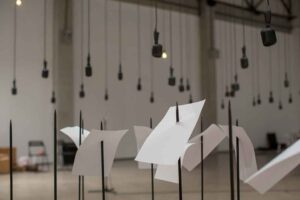
Are all the senses actively taking part in the fruition of an aesthetic experience so that we can be said to ‘benefit’ from a work of art?
The almost compulsive institutionalising of art objects into museums has weakened the cultural relationship between the viewer and the work of art: the eyes have become the privileged interlocutor of the brain while it is no longer possible to touch the surface of a canvas or smell the oil paint. Even a constructive debate in front of an artwork is often considered inappropriate because it creates disarray in a place designated for the silent enjoyment of culture.
Contemporary art seems to be slowly rebelling against this apathetic fruition and standardization of art, promoting a multisensory beauty.
The Indian artist Shilpa Gupta in her installation For, in your tongue, I cannot fit (2017-2018) seems to have knocked down these artificial boundaries between her work and the visitor; indeed the latter becomes a part of it. The endless labyrinth of words, which address the violence of censorship, gives a voice to those who no longer have one, accompanying the viewer within an area equipped with printed works from incarcerated poets, played by reverse-wired microphones set to function as speakers. Yet only the almost unintentional slow progress of the viewer inside the room gives life to the work, sacralizing it and making it the means by which the visitor finds himself in a new dimension that can finally be enjoyed through all the five senses: hearing, smell, sight, sound and touch.
Hence, the collection of sensations related to the works of Shilpa Gupta offers insight into how our societies function for a personal reflection on where art leads us and how objects can affect human behaviour. I really hope that this short journey inside one of her masterpieces has intrigued you, providing a cue for a debate about what art was, is and will be in the future.
Anita Di Rienzo
Volume 34 no 3 January – February 2020 p 25
